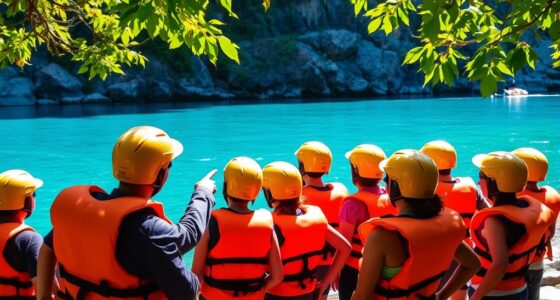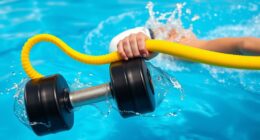To practice eco-friendly water adventures, choose sustainable gear made from eco-conscious materials and avoid single-use plastics. Respect wildlife by keeping your distance and staying on established trails. Follow Leave No Trace principles by packing out all trash and minimizing water disturbance. Support responsible tour operators who prioritize conservation and renewable energy. Educate yourself and others on water preservation, and get involved in community clean-ups. Keep exploring to discover more ways to enjoy water activities sustainably.
Key Takeaways
- Use biodegradable gear, reusable containers, and sustainable fabrics to minimize waste and environmental impact.
- Maintain safe distances from wildlife, avoid habitat disturbance, and follow local conservation guidelines.
- Pack out all trash, reduce water use, and stick to established routes to leave water bodies pristine.
- Organize or participate in local clean-up events and promote awareness through community engagement.
- Choose eco-certified tour operators that utilize renewable energy, eco-friendly equipment, and support conservation efforts.
Choosing Sustainable Gear and Equipment

When selecting gear and equipment for water adventures, prioritize sustainable options that minimize environmental impact. Choose items made from eco-friendly materials, and look for gear that lasts longer to reduce waste. Use biodegradable detergents when cleaning gear or equipment, as they break down naturally and don’t pollute waterways. Opt for solar-powered devices, such as chargers or lights, which harness renewable energy and eliminate reliance on batteries or fossil fuels. These choices not only lower your carbon footprint but also promote responsible outdoor practices. Incorporate eco-conscious design awareness into your gear choices to ensure clear visuals and reduce the need for additional electronic devices, which can contribute to environmental waste. Avoid single-use plastics and gear with non-recyclable components. By making conscious decisions about your gear, you support the health of aquatic ecosystems and help ensure that water adventures remain sustainable for future generations. Additionally, selecting gear with sustainable manufacturing practices helps minimize the overall environmental footprint of outdoor equipment. Being mindful of water conservation during your activities also plays a crucial role in protecting water resources and promoting sustainability. Incorporating environmental impact considerations into your gear selection can further enhance your commitment to eco-friendly practices.
Respecting Local Wildlife and Habitats

Choosing eco-friendly gear helps protect waterways, but respecting local wildlife and habitats takes your conservation efforts further. When you visit natural areas, stay at a safe distance from marine life to avoid disturbing their behaviors. Respecting habitats means avoiding trampling on fragile ecosystems like coral reefs or nesting sites, which are essential for marine conservation. If you’re into wildlife photography, be patient and gentle—don’t use flash or intrusive equipment that could stress animals. Remember, your actions can impact entire ecosystems, so always follow local guidelines and avoid collecting shells or plants. Additionally, payment solutions tailored for eco-tourism can facilitate responsible tourism by supporting conservation initiatives and eco-friendly businesses. By being mindful, you help preserve the health of aquatic environments and support the ongoing efforts to protect marine life and their habitats. Practicing active listening and being empathetic to wildlife behaviors can enhance your understanding of the ecosystem’s needs. Learning about marine ecosystems underscores the importance of every species within these habitats. Moreover, understanding conservation practices can empower you to make more impactful choices during your adventures. Being aware of pollution sources and minimizing waste can further reduce your environmental footprint. Your respect makes a real difference.
Minimizing Plastic Waste and Single-Use Items

Reducing plastic waste and avoiding single-use items are essential steps in protecting aquatic environments. When you bring only what you need, you help prevent pollution and harm to marine life. To minimize waste, consider these actions:
- Use a reusable bottle instead of disposable plastic bottles.
- Pack snacks in eco-friendly containers rather than plastic wrap.
- Opt for biodegradable soaps to wash up without polluting water sources.
- Avoid single-use utensils by bringing your own reusable cutlery.
- Incorporate sustainable practices into your water adventures to further reduce environmental impact, such as choosing environmentally friendly gear made from biodegradable materials. Additionally, supporting brands with transparent supply chains ensures your gear is ethically produced and environmentally conscious. Being aware of toilet functionality issues can prevent accidental environmental contamination during travel.
Practicing Leave No Trace Principles

Practicing Leave No Trace principles guarantees that your water adventures leave minimal impact on the environment. You should plan ahead to avoid damaging sensitive areas and stick to established trails and water routes. Always dispose of waste properly, packing out all trash and avoiding pollution of water sources. Be mindful of water conservation by avoiding unnecessary use and ensuring your activities don’t disturb aquatic life. Respect wildlife by observing from a distance and refraining from feeding or disturbing animals. Keep noise levels low and avoid altering natural features. Remember, leaving no trace means leaving water bodies and surrounding areas just as you found them. To minimize environmental disturbance, follow guidelines that help protect the ecosystems you enjoy exploring today. Incorporating positive thinking into your mindset can also enhance your appreciation for nature and foster a greater sense of environmental responsibility mindset. Recognizing the importance of environmental impact helps reinforce your commitment to sustainable practices. Developing an understanding of ecological balance can further improve your ability to minimize your footprint during water activities. Being aware of local regulations and respecting them ensures that you contribute positively to conservation efforts.
Supporting Eco-Friendly Tour Operators

Supporting eco-friendly tour operators is a vital step in ensuring your water adventures stay sustainable. By choosing operators committed to marine preservation, you help protect delicate ecosystems and promote responsible tourism. To identify such operators, look for these key signs:
- They hold recognized eco tourism certification, demonstrating their commitment to sustainable practices.
- They prioritize minimal environmental impact through eco-friendly equipment and waste management.
- They educate clients about local marine life and conservation efforts.
- They partner with local communities to support conservation initiatives and sustainable development.
- They incorporate renewable energy solutions, such as solar or wind power, to reduce their carbon footprint and promote clean energy use on their tours. Additionally, selecting operators who utilize environmentally friendly equipment can further enhance your eco-conscious water adventures. Practicing stillness during your tours can deepen your connection with nature and promote mindfulness, making your experience more meaningful. Engaging in mindful water practices can also help preserve the natural environment for future generations. Being aware of the importance of conservation can inspire more responsible behavior during your water activities.
Educating Yourself and Others About Conservation

Learning about marine conservation empowers you to make informed choices and advocate for healthier aquatic environments. By understanding the importance of water conservation, you can reduce your water use during water adventures and encourage others to do the same. Environmental education helps you recognize how human activities impact marine ecosystems and highlights ways to minimize harm. Share this knowledge with friends and fellow enthusiasts to spread awareness and foster responsible behaviors. Reading articles, attending workshops, or taking part in conservation programs deepens your understanding and skills. When you educate yourself about conservation, you become a more effective advocate for protecting water resources. Your awareness can inspire others to adopt eco-friendly practices, ultimately contributing to healthier oceans and water bodies for everyone.
Participating in Community Clean-Up Initiatives

Getting involved in community clean-up initiatives is a great way to protect water environments. You can organize local events, use eco-friendly supplies, and encourage others to join. Together, these efforts raise awareness and make a real difference.
Organize Local Events
Organizing local events like community clean-up initiatives can make a significant impact on preserving water quality and promoting eco-friendly practices. You can encourage others to join and create meaningful change. To guarantee success, consider these steps:
- Promote volunteer opportunities widely to attract diverse participants.
- Establish clear safety protocols to protect everyone during the event.
- Provide necessary supplies like gloves and trash bags.
- Coordinate with local authorities for permits and support.
Use Eco-Friendly Supplies
Using eco-friendly supplies during community clean-up initiatives is essential for minimizing environmental impact and promoting sustainable practices. When you choose biodegradable containers, you reduce plastic waste and guarantee materials break down naturally without harming ecosystems. Wearing eco-friendly apparel made from sustainable fabrics not only supports eco-conscious fashion but also minimizes pollution caused by synthetic fibers. These small but impactful choices show your commitment to protecting water sources and local habitats. Carry reusable tools and avoid single-use plastics whenever possible. By using biodegradable containers and eco-friendly apparel, you set a positive example for others and contribute to a cleaner, healthier environment. Your efforts help preserve water quality and promote sustainable community practices, making your participation more effective and inspiring others to follow suit.
Promote Community Awareness
Participating in community clean-up initiatives offers a powerful way to raise awareness about water conservation and environmental health. By engaging in local efforts, you help foster community storytelling that highlights shared values and encourages collective action. Building local partnerships amplifies your impact, making clean-ups more effective and sustainable. Here are some ways to promote community awareness:
- Share your experiences on social media to inspire others and showcase community efforts.
- Collaborate with local schools and organizations to educate about water issues.
- Organize events that highlight water conservation tips during clean-up days.
- Use community storytelling to highlight success stories and motivate ongoing involvement.
Your active participation helps create a ripple effect, increasing awareness and encouraging others to protect our water resources.
Frequently Asked Questions
How Can I Measure the Environmental Impact of My Water Activities?
To measure your water activities’ environmental impact, start with an Eco Impact Assessment, which evaluates your overall effect on water resources. Conduct a Water Footprint Analysis to track your water usage and identify areas to reduce waste. These tools help you understand your impact, make informed decisions, and adopt more sustainable practices. Regular assessments ensure you’re actively minimizing your footprint and protecting aquatic environments during your water adventures.
Are There Specific Certifications for Eco-Friendly Water Adventure Operators?
Think of eco certifications as your compass guiding you through the lush forest of sustainability standards. As an operator, you can earn certifications like Green Seal or EcoLabel, which verify your commitment to eco-friendly practices. These badges show your guests you’re dedicated to protecting water ecosystems and following sustainable standards. Pursuing these certifications not only boosts your credibility but also helps preserve the natural beauty you cherish on every adventure.
What Are the Best Ways to Offset My Carbon Footprint From Water Trips?
To offset your carbon footprint from water trips, you should focus on water conservation by reducing unnecessary water use and supporting eco-friendly gear that minimizes environmental impact. You can also invest in carbon offset programs, such as planting trees or supporting renewable energy projects. By combining these actions, you actively reduce your environmental impact, ensuring your water adventures are more sustainable and aligned with eco-friendly practices.
How Can Technology Enhance Sustainable Water Adventure Practices?
Technology can greatly enhance your sustainable water adventures by using sensor technology to monitor environmental impacts in real-time, helping you minimize harm. Opt for eco-friendly gear made with sustainable materials, reducing your ecological footprint. These innovations enable you to make informed decisions, like avoiding sensitive habitats or adjusting your activities accordingly. Embracing such advancements guarantees your water trips stay enjoyable while protecting the environment for future adventures.
What Policies Support the Protection of Aquatic Ecosystems During Recreation?
You can support policies that protect aquatic ecosystems by advocating for the designation of Marine Protected Areas, which limit harmful activities and preserve biodiversity. Additionally, promoting adherence to Water Quality Standards guarantees recreational activities don’t degrade water health. By staying informed and encouraging responsible policies, you help safeguard aquatic environments, ensuring they remain vibrant and healthy for future water adventures.
Conclusion
So, next time you hit the water, remember your eco-friendly practices—because nothing says adventure like leaving behind a spotless, thriving habitat. Ironically, by doing less harm, you’ll actually have more fun and create lasting memories. Who knew that protecting nature could be the ultimate thrill? So go ahead, make waves responsibly—your future self and the planet will thank you, even if they’re secretly applauding your “green” rebellion.










